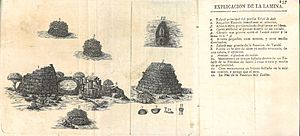Antigüedades célticas de la isla de Menorca facts for kids
Antigüedades célticas de la isla de Menorca ("Celtic Antiquities of the Island of Menorca") is a book about ancient times. It was written by Juan Ramis y Ramis (1746–1819) from Menorca. The book was printed in Mahón in 1818. It is the very first book in Spain completely about prehistory.
Contents
About the Author and His Book
Juan Ramis y Ramis wrote Antigüedades célticas de la isla de Menorca near the end of his life. He started it in 1814 and worked on it until he died in 1819. This book focuses on the history of Menorca. It brings together ideas from his other works. Some of his other books were Alquerías de Menorca (1815) and Varones Ilustres de Menorca (1816).
At this time, Menorca was ruled by Spain. Before this, it had been ruled by Britain and France. Ramis usually wrote in Catalan. But for this book, he wrote in Spanish. He wanted people in the rest of Spain to learn about Menorca's unique history.
What the Book is About
This book explores the very old history of Menorca. It was meant to be part of a larger set of books. These books would cover the island's civil and political history. But only the first part was published. Ramis passed away a year later.
Ramis's book has an introduction and ten chapters. He looked at Menorca's ancient past. He followed ideas popular in Europe in the 1700s. People back then thought that large stone buildings, called megaliths, were built by the Celts.
Exploring Ancient Monuments
In his chapters, Ramis sorted the ancient buildings into types. He used names that we still use today. These include talayots, taula enclosures, and navetas. He also shared some ideas about them. However, these ideas are not believed anymore. This is because we know more about the Talaiotic culture now. Many archaeological excavations in the 1900s helped us learn more.
For example, Ramis thought the Celts built most of the monuments. He also believed that most of these buildings were for religious purposes.
Ramis's Research Methods
Ramis based his writings on old traditions. He tried to explain ancient remains using old written records. But he also used different types of ancient objects and buildings. This helped him learn about the past. He also had an idea about why ancient settlements were spread out unevenly. He correctly guessed it was because of the different types of soil.
It is also important that he listed many ancient sites. Today, we know of about 350 talayots. Ramis mentioned 195 of them in his book. This shows he was not just a scholar working from his desk. He also explored the island.
Old Ideas and New Discoveries
Ramis's work showed a modern way of thinking for his time. But it also had some older ideas. For example, he talked about the first settlers coming from biblical roots. He also mentioned writers who thought the Celts came from Tubal and Tarsis.
A truly scientific study of Menorca's ancient buildings started later. This happened when Émile Cartailhac published his book. It was called Monuments Primitifs des Iles Baleares (Primitive monuments of the Balearic Islands). This book came out in 1892. This was almost 30 years after archaeology became a proper science.
Ramis was the first person to write about the naveta d'Es Tudons. But he did not know what it was. He thought it was a temple for the goddess Isis. Later, in the 1900s, archaeologists Maria Lluïsa Serra Belabre and Lluís Pericot dug there. They found out it was actually a tomb for many people.
Protecting History
Ramis also showed a modern idea by defending historical sites. He was very upset when some grinding stones at an ancient site were partly destroyed. This happened a few years before his book was published.
Book Structure
- Prologue
- Introduction
- Chapter I: Which families or peoples first lived in Menorca?
- Chapter II: How Celts from other places built similar buildings to those in Menorca
- Chapter III: When talayots were built on the island, how they were made, and what they were for
- Chapter IV: About the stone circles and pillars near the talayots
- Chapter V: About the large and small taulas or altars
- Chapter VI: About the amolons (grinding stones) found near talayots and circles. Also about two mill wheels on top of the Torelló talayot
- Chapter VII: About the man-made caves near the talayots in Menorca
- Chapter VIII: About the ship-shaped building in Es Tudons, near Ciutadella
- Chapter IX: Different facts about the druids
- Chapter X: Ideas about two old monuments recently found on the island
- Watchtowers on the island of Menorca, known as talayots
See also
 In Spanish: Antigüedades célticas de la isla de Menorca para niños
In Spanish: Antigüedades célticas de la isla de Menorca para niños
- Talaiotic culture
- Juan Ramis


